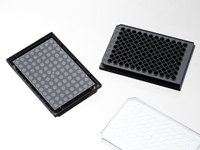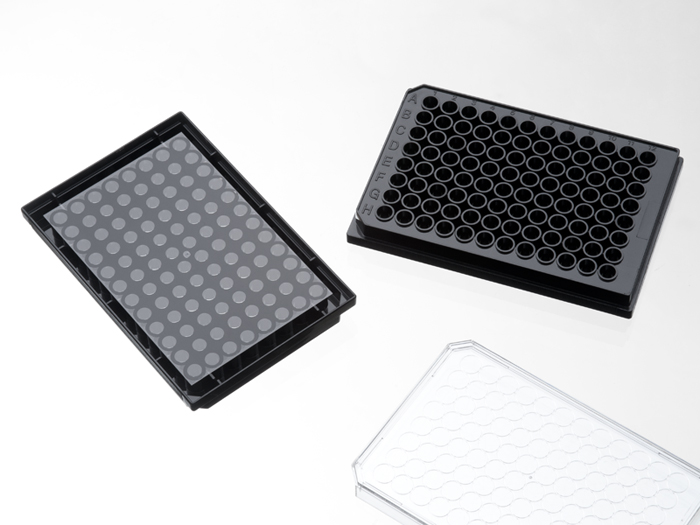96 Well glass bottom plates


Designed for high resolution imaging such as confocal microscopy.
96 well glass bottom plates are suitable for high throughput assays.
* Click individual products to view detailed technical specs. request a free sample or get a quote.
** We are sorry to increase our price for US customers starting from 6/1/2025 due to the significant increase of US tariff.
| Product # | Well Size | Coverslip » view coverslip spec | Packing | Price(case) |
|---|---|---|---|---|
| P96-0-N | 6.0 mm | #0 | 20/case | $283.00 USD |
| P96-1-N | 6.0 mm | #1 | 20/case | $283.00 USD |
| P96-1.5H-N | 6.0 mm | #1.5H | 20/case | $311.00 USD |
| P96-1.5P | 6.0 mm | #1.5P | 20/case | $276.00 USD |
| P96LB-1.5H | 6.0 mm | #1.5H | 20/case | $311.00 USD |
Features
- Suitable for long term tissue culture
- Manufactured in a class 100,000 clean room
- 96 well plates are made from virgin polystyrene.
- German cover glass or glass-like cover slip of superior optical quality
- A USP class VI adhesive is used to assemble the cover glass and the plate.
- Individually packed in easy to open trays
- Sterilized by Gamma radiation.
- Conforms to ANSI/SBS 1-2004 standards
Cited publications before 2019 (52)
-
Superresolution microscopy with novel BODIPY-based fluorophores
Amy M. Bittel, et al., Plos One, October 26, 2018
Quote: "GLOX oxygen scavenger, redox reagent, and additives were mixed and added to the sample 10–30 min before imaging in a sealed 96 well plate with cover glass bottom (CellVis, Mountain View, CA)." -
Microtubules Gate Tau Condensation to Spatially Regulate Microtubule Functions
Ruensern Tan, et al., BioRxiv, September 22, 2018
Quote: "Continuous imaging assays: Tau condensation assays (Fig. 1A-C, S1A) were conducted in Cellvis 96-well Glass Bottom Plate (Cellvis, #P96-1.5H-N) as previously described" -
Inhibitor experiments Fresh isolated human neutrophils (10,000 per well) were seeded in 96-glassbottom-well-plates (In vitro scientific) and activated for NETosis with PMA, final concentration 100 nM
Elsa Neubert, et al., Nature Communications volume 9, Article number: 3767 (2018)
Quote: "Inhibitor experiments: Fresh isolated human neutrophils (10,000 per well) were seeded in 96-glassbottom-well-plates (In vitro scientific) and activated for NETosis with PMA, final concentration 100 nM" -
A FRET-Based approach to study the SUMOylation of Serotonin 1A Receptors
S Kaur, et al., Ku Schoolworks, 2018
Quote: "or in 96-well glass bottom plates (Catalog no. #P96-1-N, CellVis, Mountain View, CA, USA) at a seeding density of 15,000 cells per well." -
Development of a Novel 3D Tumor-tissue Invasion Model for High-throughput, High-content Phenotypic Drug Screening
T. J. Puls, et al., Nature: Scientific Reports, volume 8, Article number: 13039 (2018)
Quote: "Overall dimensions and post spacing were optimized to accommodate glass-bottom 96-well plates (Cellvis, Mountain View, CA; Supplemental Fig. S1)." -
Parallel High-Resolution Imaging of Leukocyte Chemotaxis Under Agarose with Rho-Family GTPase Biosensors
GRR Bell, et al., Rho GTPases pp 71-85, 2018
Quote: "Imaging Materials. 1. Glass-bottom 96-well plate (Cellvis, Catalog #P96–1.5HN or equivalent)" -
Ki67 is a Graded Rather than a Binary Marker of Proliferation versus Quiescence
I Miller, et al., Cell Reports, Volume 24, Issue 5, 31 July 2018, Pages 1105-1112
Quote: "96 well glass bottom plate, Cellvis, Cat# P96-1.5HN" -
Nile Red derivatives enable improved ratiometric imaging for nerve-specific contrast
Jesse R. Korber, et al., J. of Biomedical Optics, 23(7), 076002 (2018).
Quote: "For imaging studies, cells were grown in 96-well glass bottom plates (Cellvis, Mountain View, California) for 48 h, with a final confluence of <80%." -
Add-on plasmonic patch as a universal fluorescence enhancer
J Luan, et al., Nature: Light: Science & Applicationsvolume 7, Article number: 29 (2018)
Quote: "Fluorescence-linked immunosorbent assay was first implemented using 96-well plates with a glass bottom (Cellvis). The glass surface of each well was treated to achieve aldehyde functionality" -
Giardia's ventral disc is hyperstable and composed of over 80 disc-associated proteins
Christopher Nosala, et al., BioRxiv July 03, 2018.
Quote: "Confocal Microscopy: 3D stacks and time lapse movies were acquired of live cells grown in 96-well #1.5 black glass14 bottom imaging plates (In Vitro Scientific)."



